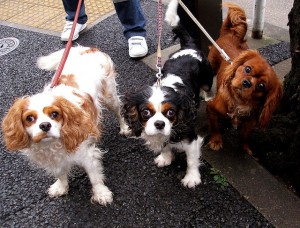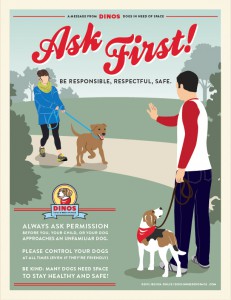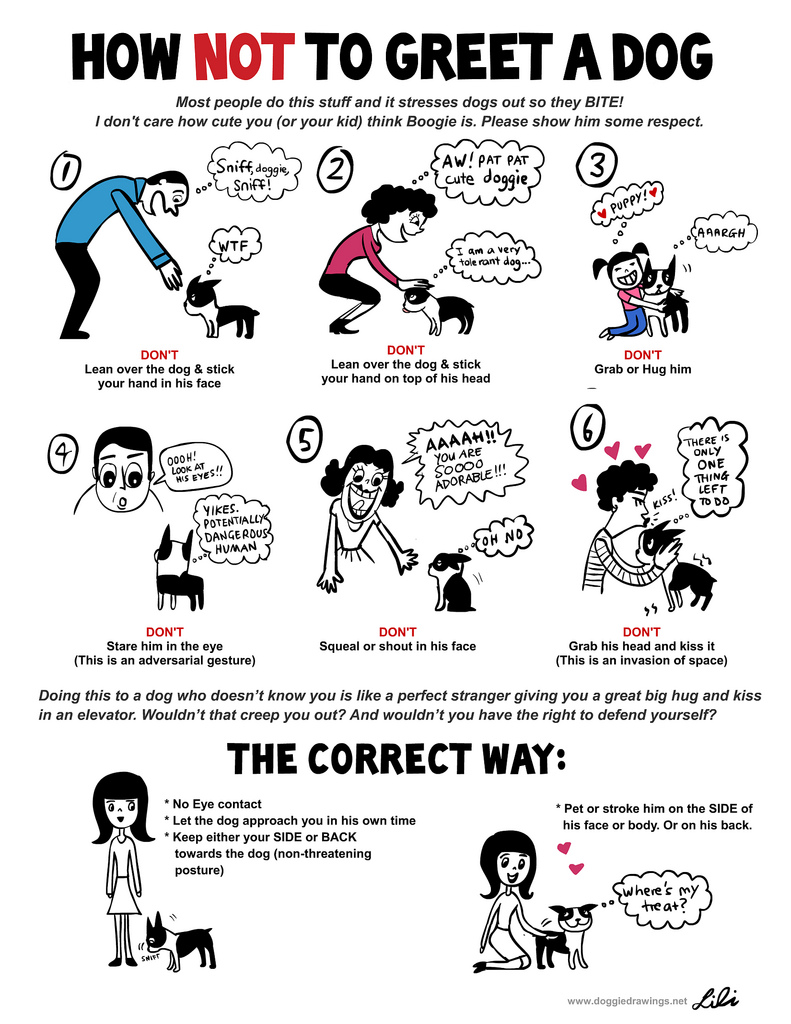Dogs, dogs everywhere!
Now that the weather is finally nice, dogs are enjoying lots of outings with their owners. And they’re all so adorable – it’s human nature to want to pet and interact with each and every one of them :-).

However, some dogs are bashful and need some time to feel comfortable before allowing you to touch them, and others might not want to be petted by strangers. What’s the best way to ensure a safe, fun interaction for all involved, and what are some signs that the dog might not appreciate the attention?
Here are some tips on How to Greet A Dog!
1) First, ASK the owner and WAIT to hear the complete answer.
Ask from a distance (in case the dog is scared of strangers), and WAIT to hear the answer before charging up. Often, people just assume the answer will be yes, and the question is just asked “because that’s what you should do to be polite”. Give the owner time to answer first. The answer may be “yes”, but it might also be “yes, but …” Wait to hear what’s on the other side of the “but”. The dog may have to sit to earn the opportunity to greet, or there may be other rules attached (such as “don’t pet her if she jumps”). Or, there may be other important instructions from the owner (such as “please let her approach you – it might take her a moment or two”, or “please pet her under the chin, not over the head”).
For example, if you see Mel uptown with a board-and-train dog, she will likely say, “yes, but… he has to sit first, and be released to go say hi”. We have noticed that most people only hear the “yes”, and as she is trying to get the dog to sit, the person charges up and starts petting. It’s a frustrating situation for the person trying to train the dog, and confusing for the dog who is trying to learn the rules.

2) If the owner says yes, then ASK the dog.
Be polite – the dog will be much more likely to want to interact with you.
- Rule 1: Do not stick your hand in a dog’s face so he can sniff you. He could smell you long before you got that close. Sticking your hand out can be considered a threatening gesture for a fearful dog, and it’s just not necessary. Everybody does it, but dogs do not appreciate it. And we’ve seen people get bitten that way. Instead, stand where you are, with your hands at your side, and let the dog come to you.
- Rule 2: If the dog does not come to you, accept that. Instead, talk to the owner about her dog. Ask his name, what his breed is, or what his favorite activity is. Perhaps with some time the dog will approach you, but if he doesn’t, he is giving you useful information – he is telling you he is not interested in interacting right now. Be polite, respect the dog’s desire for distance, and don’t push the issue.
- Rule 3: Pay attention to the dog’s body language. Learn to read canine communication — their body language will tell you if they are comfortable or not. Signs of stress can include tongue flicks, yawning, and turning away. Also, be aware that a wagging tail does not always indicate friendliness. Here is a great video on canine body language — watch it and learn how to read what dogs are telling you!
3) If the owner says no, please respect that.
And don’t get offended, or say something passive-aggressive about how if the dog can’t be petted it shouldn’t be out and about. Dogs are not public property. You have no more of a “right” to go up and pet any dog in public than you do to hug someone’s child. There are many valid reasons an owner may say no:
- The dog may be shy and learning to be comfortable in public, and trying to pet the dog might scare him and set back his behavior modification program.
- The dog may be a service dog doing his job, or a service dog in training, and should not be distracted.
- The dog may be in training, learning to ignore the distractions around him (including friendly strangers).
- The dog may not feel well, and may not be in the mood for interactions with strangers.
- The dog may be tolerant of touching by strangers, but might simply not enjoy it.
4) When the dog approaches you, pet him on the chin or chest – not on top of the head.
Use proper dog-greeting etiquette! Most dogs aren’t comfortable with hands reaching over their heads. It’s the way humans tend to pet, but it’s not the way dogs would prefer to be petted. If you do it anyway because you forgot and the dog pulls his head away, don’t do it again – instead, try reaching under the chin and then working around towards the ears or to the chest. Also, don’t loom over the dog – they can find that scary. Bend at the knees, not at the waist.

5) Follow the 5-second rule.
Pet the dog for 5 seconds, and then stop. WAIT and see if he asks for more. If not – respect that. Some dogs want only a small amount of touching from strangers, and then they’re done – if they retreat, they’re telling you they don’t want more petting at the moment. Don’t walk after the dog to pet him more – wait until he approaches you again. If he does not, see #2 above.
If you follow the rules above, you can help dogs feel at ease, and you will also greatly reduce the chance of a bite. As a bonus, you’ll be pleasantly surprised at how many dogs choose to approach you for petting, and at how many owners say “wow, Fido doesn’t approach many people – he must really like you!”
